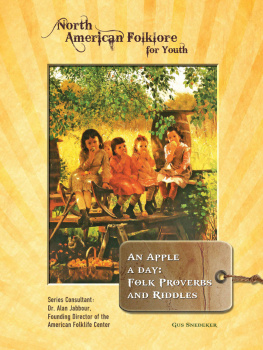NEW BOOKS FOR NEW READERS
Judy Cheatham
General Editor
KENTUCKY FOLKLORE
R. Gerald Alvey
THE UNIVERSITY PRESS OF KENTUCKY
The New Books for New Readers project was made possible through funding from the National Endowment for the Humanities, the Kentucky Humanities Council, and The Kentucky Post. The opinions expressed in this book are not necessarily those of the Kentucky Humanities Council.
Copyright 1989 by The Kentucky Humanities Council
Published by The University Press of Kentucky
Scholarly publisher for the Commonwealth,
serving Bellarmine University, Berea College, Centre College of Kentucky, Eastern Kentucky University, The Filson Historical Society, Georgetown College, Kentucky Historical Society, Kentucky State University, Morehead State University, Murray State University, Northern Kentucky University, Transylvania University, University of Kentucky, University of Louisville, and Western Kentucky University.
All rights reserved.
Editorial and Sales Offices: The University Press of Kentucky
663 South Limestone Street, Lexington, Kentucky 40508-4008
www.kentuckypress.com
13 12 11 10 09 10 9 8 7 6
Library of Congress Cataloging-in-Publication Data
Alvey, R. Gerald, 1935
Kentucky folklore / R. Gerald Alvey.
p. cm. (New books for new readers)
ISBN-10: 0-8131-0902-7 (alk. paper)
1. FolkloreKentucky. 2. FolkloreAppalachian Region. 3. Oral traditionKentucky. 4. Oral traditionAppalachian Region. 5. KentuckySocial life and customs. 6. Appalachian RegionSocial life and customs. 7. Readers for new literates.
I. Title. II. Series.
GR110.K4A48 1989
ISBN-13: 978-0-8131-0902-2 (pbk.: alk. paper)
This book is printed on acid-free recycled paper meeting the requirements of the American National Standard for Permanence in Paper for Printed Library Materials.
Manufactured in the United States of America.
| Member of the Association of American University Presses |
Contents
Foreword
The New Books for New Readers project was made possible through funding from the National Endowment for the Humanities, the Kentucky Humanities Council, and The Kentucky Post. The co-sponsorship and continuing assistance of the Kentucky Department for Libraries and Archives and the Kentucky Literacy Commission have been essential to our undertaking. We are also grateful for the advice and support provided to us by the University Press of Kentucky. All these agencies share our commitment to the important role that reading books should play in the lives of the people of our state, and their belief in this project has made it possible.
The Kentucky Humanities Council recognizes in the campaign for adult literacy a cause closely linked to our own mission, to make the rich heritage of the humanities accessible to all Kentuckians. Because the printed word is a vital source of this heritage, we believe that books focused on our states history and culture and written for adults who are newly learning to read can help us to serve a group of Kentuckys citizens not always reached or served by our programs. We offer these books in the hope that they will be of value to adult new readers in their quest, through words, for an understanding of what it means to be human.
Ramona Lumpkin, Executive Director
Kentucky Humanities Council
Acknowledgments
This book has been produced with support from the National Endowment for the Humanities, the Kentucky Humanities Council, the Kentucky Literacy Commission, and the University Press of Kentucky. I also wish to thank Joyce Toliver, the coordinator, and all the other people at the Pendleton County Adult Reading Program for their suggestions and editorial assistance: Mark Blanton, E. D., Bobbie Gay, Lois Gibbons, Rex Howard, Lewis Hulley, Judy Miles, Jeff Reinzan, Virginia Shotwell, and Loretta Simpson. Finally, I thank my wife, Donna, a teacher of young people for many years, who read the manuscript and offered suggestions to improve its readability level.
Introduction
This book is about folk culture and folklore in Kentucky. Before talking about folk culture, we need to understand what culture is. Culture is a body of knowledge shared by a group of people. It is also how they learn or acquire that knowledge and how they express that knowledge with one another. Culture includes the way people talk, dress, cook, eat, and act. Culture includes peoples beliefs about God and the supernatural, and how they view themselves and other people. Culture also includes all the material objects people create, such as barns, fences, houses, quilts, and musical instruments.
Lifestyle is a current term that means almost the same thing as culture. But culture includes many more things than a lifestyle. Also, people usually choose their lifestyle when they become adults. People do not choose their culture. People learn their culture from the time they are born. People learn how to talk, act, etc.how to livefrom family, friends, and others around them as they grow up. Often, people are not even aware that they are learning their culture.
In general, culture is the way people learn to live their lives. There are three kinds of culture in Kentucky and the rest of the United States: elite, popular, and folk culture.
Elite culture is the official, formal culture. You learn elite culture in schools, in churches, from the government, or from any official, formal source. For example, when teachers tell students to say I do not have any instead of I aint got none, they are teaching the students elite culture.
Elite culture has many rules and guidelines. These rules are rigid, and we must follow them. For example, when a doctor prescribes a medicine, we must take it at exact times so it will work. When the government passes tax laws, we must obey them or we will be fined or sent to jail.
The main purpose of elite culture is to help people to be better human beings, to live better lives, and to make the world a better place. In fact, the reason you are reading this book, learning to read, and learning to think about these things is all part of elite culture. You will be better because of these things.
Popular culture is the second kind of culture in Kentucky and the rest of the United States. Unlike elite culture, we do not learn popular culture in schools. We learn popular culture from TV, radio, newspapers, magazines, movies, and commercials. For example, from popular culture we learn what brand of deodorant is manly, what kind of detergent to use for the whitest, brightest clothes, and which pill will cure our headaches the quickest.
Generally, popular culture is commercial culture. Popular culture, for the most part, exists to make money. In order to make lots of money, popular culture must appeal to many people. It must also change constantly, because people want to buy whatever is new or trendy or the in thing. Therefore, popular culture does not last very long. Popular culture is faddish. Its here today and gone tomorrow.







